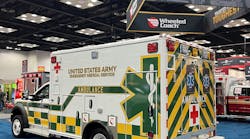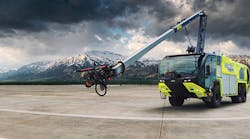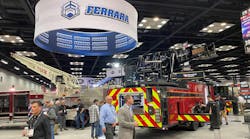The first common factor, the one that causes a majority of apparatus rollovers, is apparatus going off the pavement and onto the shoulder of the road. In the apparatus driving classes that I teach there are several commonly asked questions. The most common is, if the apparatus leaves the pavement, how do I bring it back onto the pavement without losing control and rolling over?
Not wanting to re-invent the wheel, I reply that the answer is contained in the U.S. Fire Administration's 1999 Firefighter Fatality report. The USFA report states that a very common scenario is for the right wheels of the apparatus to leave the road for some reason, for the driver to fight to regain control of the vehicle, and for the vehicle to collide with a fixed object such as a tree or rollover when the apparatus leaves the left side of the road. Fire apparatus are wide vehicles and fire apparatus drivers/operators may have a tendency to hug the right side of the road.
The following guidelines can help to reduce the incidence of this type of collision or to reduce the severity of such collisions.
- Fire apparatus drivers/operators must limit their speed to one that is reasonable for the road conditions, the size of the vehicle, the configuration of the vehicle, the topography of the response route (curves, hills) and visibility (fog, dark, precipitation). Many fire departments have adopted speed limits for responding apparatus that are a maximum of 10 mph above the posted speed limit if conditions permit. In some areas or states, fire apparatus may not be permitted to travel above the speed limit in any situation. In many of the collisions described in our case studies, speed was a contributing factor.
- Younger or inexperienced drivers demand special attention to reinforce the importance of speed control and decisions about the need to respond safely.
- If possible, avoid small roads with no improved shoulders. This is not possible or practical in all situations, especially emergency response.
- The apparatus driver/operator should use as much of the road as is needed to operate safely. Especially during an emergency response where traffic is yielding, a position closer to the center of the road will prevent slipping off to the right. In some situations, such as in curves and on hills, the best place for responding apparatus is in their defined lane at a slower speed.
- If a vehicle leaves the right side of the road and conditions permit, the driver should take his or her foot off of the throttle and slow to a speed that allows the vehicle to come back onto the roadway safely. "Fighting" to get the vehicle on the road at speed may lead to a collision or rollover.
- A publication available from the USFA, Emergency Vehicle Driver Training, provides excellent information on driver safety for emergency vehicles. The publication, FA-110, is free and can be obtained through the Internet as a PDF document; as a hard copy at http://www.usfa.fema.gov/usfapubs; or by writing to U.S. Fire Administration, Publications Center, 16825 South Seton Ave., Emmitsburg, MD 21727. Also, you can obtain a copy of the 1999 Firefighters Fatality Report from the USFA or on the Internet at http://www.firehouse.com.
I would like to address a few issues contained in the excerpts from the USFA report:
Speed. Individual states and their municipalities have set speed limits. Putting speed limits in fire department operating guidelines and procedures could be counter productive. If a state, such as my state, New York, has a statute that will enable emergency vehicle operators to exceed maximum speed limits so long as the driver/operator does not endanger life or property why would the fire department put in writing that fire apparatus should not go over 10 mph over the posted limit?
Depending on many factors, if a fire department's own guidelines are more restrictive than the state's, that information could be used against the fire department in a civil liability action. Chief and company officers should deal with apparatus speed as a driver training issue and as a reckless driving prevention issue with enforcement of safe driving practices.
Age. The age of apparatus drivers/operators is another frequently raised issue. What is the proper age for a young firefighter to start to drive and what is the appropriate age for a senior driver/operator to retire or step down from driving duties?
The answer is not an easy one, but an excellent driver training program, with a good driver trainer, with good driver training drills and with a proper annual driver/operator recertification procedure could go a long way to answering the question of age.
Once, a chief officer came up to me after a class and proclaimed that he had written in his operating guidelines that drivers had a mandatory retirement age of 60. My reply to the chief was to rescind this guideline immediately as it clearly violates civil disabilities law and demonstrates age discrimination practices by the fire department.
As far as young drivers are concerned, there is no magical age when to start. Some young firefighters mature earlier and come into there own at relatively young ages while other firefighters that I know who are 30 or 40 years old have never grown up, are not mature and would make poor apparatus operators. That is why the value of a good driver training program cannot be overstated and can act as a vehicle to weed out potentially dangerous or reckless operators.
In part two of this column we will discuss additional lessons to be learned, as well as some accident avoidance tips.
Finally, as we went to press a tillered ladder from the Hyattsville, MD, Fire Department was involved in a serious accident on Interstate 81 in Pennsylvania, near Wilkes-Barre. On board the apparatus at the time of the accident were a driver, an officer and the tillerman. The driver and the officer had to be extricated and the tillerman was ejected. All received serious injuries. Our wishes for a speedy recovery go out to the crew of the Hyattsville Truck 1 and are heartfelt thoughts and prayers go out to all of the officers and firefighters of the Hyattsville Fire Department. As more details become available I will have them in future Emergency Vehicle Operations columns.
Michael Wilbur, a Firehouse® contributing editor, is an FDNY lieutenant in Ladder Company 27 in the Bronx and a firefighter in the Howells, NY, Fire Department. He is an adjunct instructor at the New York State Academy of Fire Science and the Orange County Fire Training Center. Wilbur has developed and presented emergency vehicle operator courses throughout the country and has consulted on a variety of fire apparatus issues.




